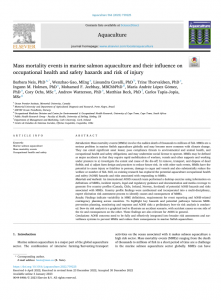ABSTRACT
Introduction: Mass mortality events (MMEs) involve the sudden death of thousands to millions of fish. MMEs are a serious problem in marine finfish aquaculture globally and may become more common with climate change. They can entail significant asset losses; pose compliance threats to environmental and animal health, and occupational health and safety obligations; and may undermine social license to operate. MMEs may be defined as major accidents in that they require rapid mobilization of workers, vessels and other supports and working under pressure to a) investigate the extent and cause of the die-off; b) remove, transport, and dispose of dead finfish; and c) adjust farm design and practices to reduce future risk. As with other such events, MMEs have the potential to cause injury or fatalities to persons, damage to cages and vessels and also substantially reduce the welfare or number of fish. Still, no existing research has explored the potential aquaculture occupational health and safety (AOHS) hazards and risks associated with responding to MMEs.
Materials and methods: An international AOHS research team performed a desktop exercise using information on definitions of MMEs, incident reports, legal and regulatory guidance and documentation and media coverage to generate five country profiles (Canada, Chile, Ireland, Norway, Scotland) of potential AOHS hazards and risks associated with MMEs. Country profile findings were synthesized and incorporated into a multi-disciplinary, expert elicitation risk assessment process to identify causes and consequences of MMEs.
Results: Findings indicate variability in MME definitions, requirements for event reporting and AOHS-related contingency planning across countries. To highlight key hazards and potential pathways between MME prevention planning, monitoring and response and AOHS risks a preliminary bow-tie risk analysis is conducted. Bow-tie risk analysis is a graphical tool to illustrate an accident scenario, with accident causes on one side of the tie and consequences on the other. These findings are also relevant for AOHS in general.
Conclusions: AOHS concerns need to be fully and effectively integrated into broader risk assessments and surveillance systems to prevent MMEs and reduce their consequences in marine finfish aquaculture.
CITAR COMO:
Barbara Neis, Wenzhao Gao M., Lissandra Cavalli, Trine Thorvaldsen , Ingunn M. Holmen, Mohamed F Jeebhay, Maria Andrée Lopez-Gomez, Cory Ochs, Andrew Watterson, Matthias Beck & Carlos Tapia-Jopia. 2023. Mass mortality events in marine salmon aquaculture and their influence on occupational health and safety hazards and risk of injury? Aquaculture, Volume 566, 15 March 2023, 739225. https://doi.org/10.1016/j.aquaculture.2022.739225



